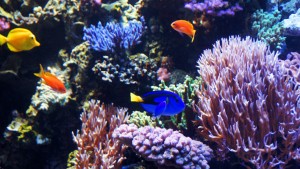Dissolved nutrients. Sounds like a good thing, right? After all, every organism needs nutrients in one form or another in order to grow and stay in good health. So why are marine aquarium hobbyists—particularly reefkeepers—seemingly so fixated on keeping the level of dissolved nutrients in their systems as low as possible?
To understand this fixation, you have to keep in mind that the waters surrounding coral reefs are naturally nutrient-poor environments. Unless a reef is subject to agricultural runoff, sewage discharge, etc., the levels of dissolved nutrients around it never approximate what can accumulate in the closed system of a marine aquarium.
Elevated dissolved-nutrient levels lead to problems with nuisance algae and declining water quality, which is stressful or even deadly to marine livestock. That’s why hobbyists must implement different measures to export dissolved nutrients from their systems.
Here’s a sampling of basic nutrient-export techniques:
The routine water change
I’ve listed the water change first because it’s the most straightforward technique and provides many additional benefits beyond exporting dissolved nutrients. You should be changing a minimum of 10 percent every week or 20 percent biweekly (more if testing shows that nitrate, and/or phosphate is exceeding the acceptable level), siphoning out as much accumulated particulate waste as possible in the process.
Note: Ensure the source water you use to mix up your salt water and to compensate for evaporation doesn’t contain nitrate or phosphate. We recommend purifying tap water (e.g., via reverse osmosis/deionization) before using it in a marine aquarium system.
Protein skimming
A good protein skimmer comes in a close second to the water change when it comes to nutrient export. When you see the brown, smelly gunk that accumulates in the skimmer’s collection cup, you’ll understand why. The great thing about protein skimming is that it removes dissolved organic compounds from the water before they even have a chance to decompose and burden the biological filter.
Macroalgae
Macroalgae, such as Chaetomorpha, grown in a sump or refugium under dedicated lights will take up dissolved nutrients from the water. Then, every time you harvest some of the algae, you’re effectively exporting the nutrients contained within the harvested tissues. Harnessing the nutrient-uptake potential of macroalgae is a great way to outcompete problem algal forms, such as hair algae, bubble algae, and BGA (aka, blue-green algae or cyanobacteria).
Rinsing or replacing mechanical filter media
Mechanical filtration, in and of itself, does not export dissolved nutrients. It merely sequesters particulate matter in some form of porous medium, which remains in the flow of water. If left in the filter medium for too long, the particulates begin to break down and actually cause the system’s dissolved-nutrient level to rise. However, regularly rinsing/back-flushing the filter medium and replacing it as needed will eliminate the particulate waste before it has a chance to decompose.
Live rock and DSBs
The use of high-quality, porous live rock and/or a deep bed (4 inches plus) of fine sand—either in your display tank or in a sump/refugium—can actually help export nitrate from your system. Deep within the structure of the live rock and in the lower reaches of the sand bed, colonies of anaerobic denitrifying bacteria thrive. These bacteria convert nitrate to free nitrogen gas, which escapes harmlessly from the water into the air.
What am I forgetting?
Do you use a nutrient-export method that I haven’t mentioned here? If so, please describe it for your fellow salties in the comment section below



